 W
WJuracimbrophlebia is an extinct genus of hangingflies that lived during the Middle Jurassic Period about 165 million years ago, containing only its type species, Juracimbrophlebia ginkgofolia; it was discovered in deposits from Daohugou in northeastern China’s Inner Mongolia.
 W
WAcridoxena is a monotypic genus of bush crickets. It is now placed in the tribe Acridoxenini of the subfamily Mecopodinae; previously it was in the subfamily Acridoxeninae. It has one species, Acridoxena hewaniana, found in western central Africa.
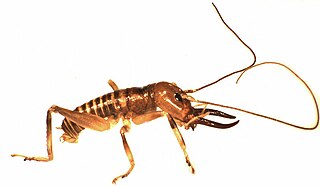 W
WThe Northland tusked wētā, Anisoura nicobarica, is a rare monotypic wētā of the family Anostostomatidae, endemic to the northern half of Northland in New Zealand. It was originally described in the ground wētā genus Hemiandrus, but was later put into a newly-created genus, Anisoura. The type specimen was wrongly labelled as coming from the Nicobar Islands, so the species was named Anisoura nicobarica.
 W
WArgosarchus is a monotypic genus in the family Phasmatidae containing the single species Argosarchus horridus, or the New Zealand bristly stick insect, a stick insect endemic to New Zealand. The name "horridus" means bristly in Latin, likely referring to its spiny thorax.
 W
WAstape is a genus of praying mantis in the family Haaniidae, containing the single species Astape denticollis.
 W
WAularches miliaris is a monotypic grasshopper species of the genus Aularches, belonging to the family Pyrgomorphidae. The bright warning colours keep away predators and their defense when disturbed includes the ejection of a toxic foam.
 W
WDactylotum bicolor, also known as the rainbow grasshopper, painted grasshopper, or the barber pole grasshopper, is a species of grasshopper in the family Acrididae. It is native to the United States, Canada and northern Mexico and exhibits aposematism. It was first described by the German entomologist Toussaint de Charpentier in 1843.
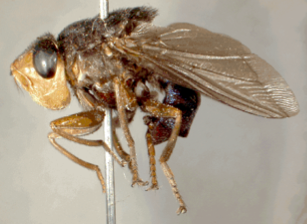 W
WThe human botfly, Dermatobia hominis, is one of several species of flies, the larvae of which parasitise humans. It is also known as the torsalo or American warble fly, though the warble fly is in the genus Hypoderma and not Dermatobia, and is a parasite on cattle and deer instead of humans.
 W
WDryococelus australis, commonly known as the Lord Howe Island stick insect or tree lobster, is a species of stick insect that lives on the Lord Howe Island Group. It was thought to be extinct by 1920, only to be rediscovered in 2001. It is extirpated in its largest former habitat, Lord Howe Island, and has been called "the rarest insect in the world", as the rediscovered population consisted of 24 individuals living on the small islet of Ball's Pyramid.
 W
WFortiholcorpa paradoxa is an extinct species of scorpionfly (Mecoptera) from the Middle Jurassic of China. It is the only known species of its genus.
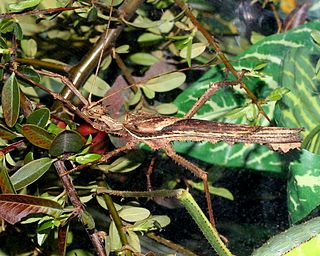 W
WHeteropteryx dilatata is a large species stick insect, in the monotypic genus Heteropteryx and typical of the family Heteropterygidae. It is commonly kept in captivity and may be known as the: jungle nymph, Malaysian stick insect, Malaysian wood nymph, Malayan jungle nymph, or Malayan wood nymph. It originates in Malaya and is nocturnal. This insect holds the human record for the largest egg laid by an insect. The eggs are about 1.3 cm (0.5 in) in length.
 W
WHippiscus is a genus of band-winged grasshoppers in the family Acrididae. There is only one described species in the genus, Hippiscus ocelote from North America.
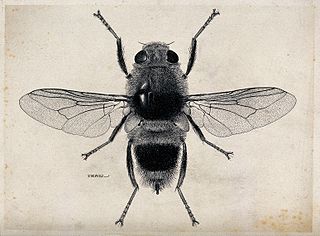 W
WWarble fly is a name given to the genus Hypoderma, large flies which are parasitic on cattle and deer. Other names include "heel flies", "bomb flies" and "gadflies", while their larvae are often called "cattle grubs" or "wolves." Common species of warble fly include Hypoderma bovis and Hypoderma lineatum and Hypoderma tarandi. Larvae of Hypoderma species also have been reported in horses, sheep, goats and humans. They have also been found on smaller mammals such as dogs, cats, squirrels, voles and rabbits.
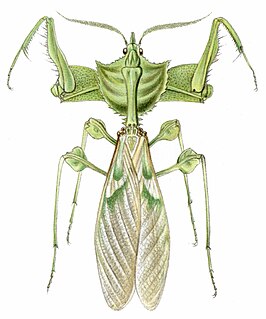 W
WIdolomantis diabolica, commonly known as the devil's flower mantis or giant devil's flower mantis, is one of the largest species of praying mantises, possibly the largest that mimics flowers. It is the only species classified in the genus Idolomantis.
 W
WLednia is a monotypic genus, containing the single species Lednia tumana —a rare, alpine, aquatic insect that is endangered due to likely loss of glaciers and snowpacks in the Glacier National Park and other habitat in the Rocky Mountains due to climate change. The insect lives in the coldest streams just downstream of the glacier or snowbank sources and is considered as an early warning indicator species of climate warming in mountain ecosystems. The Fisheries and Wildlife Service is being petitioned to protect the species under the U.S..Endangered Species Act.
 W
WThe migratory locust is the most widespread locust species, and the only species in the genus Locusta. It occurs throughout Africa, Asia, Australia and New Zealand. It used to be common in Europe but has now become rare there. Because of the vast geographic area it occupies, which comprises many different ecological zones, numerous subspecies have been described. However, not all experts agree on the validity of some of these subspecies.
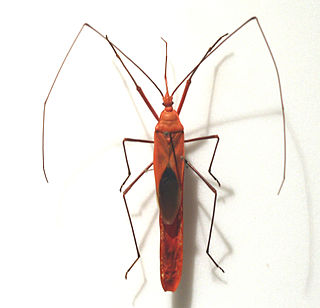 W
WMacrocheraia is a genus of bugs in the family Largidae with a single species, Macrocheraia grandis found mainly in Southeast Asia but extending into parts of South Asia. This was referred to in some older literature under the genus Lohita, a name derived from the Sanskrit word for red.
 W
WMyrmecomantis atra, common name ant mantis, is a species of praying mantis that relies upon ant mimicry for protection even as an adult.
 W
WNiveaphasma annulata is a species of stick insect found in New Zealand.
 W
WNotiothauma is the sole living genus in the scorpionfly family Eomeropidae. The genus is monotypic with a lone species Notiothauma reedi which is native to the Valdivian temperate rain forests of central Chile, especially the forests with Nothofagus stands. N. reedi is flattened with a notedly cockroach-like in appearance. They are nocturnal and inhabit the forest floor where the adults feed on plants and decaying animals. The larvae are still unknown. Because this is the last extant species of Eomeropidae, N. reedi can be characterized as a living fossil taxon.
 W
WOannes spinosus is a species of leaf-footed bug known from South Africa.
 W
WParamonovius nightking is a species of bee fly in the family Bombyliidae that is endemic to a restricted area of western Australia. It is the only member of the monotypic genus Paramonovius. Based on morphology, it is the sister genus to Sisyromyia.
 W
WParaneonetus is a monotypic genus of wētā containing the species Paraneonetus multispinus, commonly known as the Three Kings cave wētā. P. multispinus is a cave wētā in the family Rhaphidophoridae, endemic to the Three Kings Islands of New Zealand.
 W
WPhosphuga is a European genus of carrion beetle, whose sole member is the species Phosphuga atrata. The beetle is up to 15mm long and has an elongated neck, which is used to reach into snail shells, which it sprays with a digestive fluid. The beetle feeds on live snails, insects and earthworms, as well as on carrion. Newly-moulted beetles are brownish in color, older ones are black. The larvae are black and flattened and feed on snails as well. They pupate in the ground.
 W
WPnigomantis medioconstricta common name Indonesian double shield mantis or double shield mantis are the only species in the genus Pnigomantis of mantis of the family Mantidae.
 W
WSchizocephala is a genus of praying mantises in the monotypic tribe Schizocephalini. It is rpresented by a single species, Schizocephala bicornis. It is distributed across Pakistan, India, Nepal, Sri Lanka and the Sunda Islands.
 W
WTectocoris diophthalmus, commonly known as the Hibiscus Harlequin Bug or Cotton Harlequin Bug, is the sole member of the genus Tectocoris. It is a brightly coloured convex and rounded shield-shaped bug with a metallic sheen that grows to about 20 mm. Adult females are mostly orange and males are both blue and red or orange, while nymphs are typically metallic green and purple. The colours are quite variable, and experiments suggest that the variation in colour may reduce bird predation, especially on the immature stages. This extreme level of variation is such that different taxonomists have, since 1781, described this species under different new names at least 16 times, some of these supernumerary names remaining in use until 2006, when it was finally confirmed that they were all colour forms of a single organism. It is common in Eastern Australia, New Guinea and several Pacific Islands in habitats ranging from urban to agricultural and coastal areas.